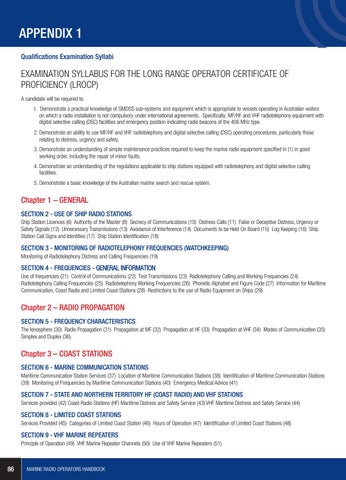APPEnDIX 1 Qualifications Examination Syllabi
EXAMINATION SYLLABUS FOR THE LONG RANGE OPERATOR CERTIFICATE OF PROFICIENCY (LROCP) A candidate will be required to: 1. Demonstrate a practical knowledge of GMDSS sub-systems and equipment which is appropriate to vessels operating in Australian waters on which a radio installation is not compulsory under international agreements. Specifically, MF/HF and VHF radiotelephony equipment with digital selective calling (DSC) facilities and emergency position indicating radio beacons of the 406 MHz type. 2. Demonstrate an ability to use MF/HF and VHF radiotelephony and digital selective calling (DSC) operating procedures, particularly those relating to distress, urgency and safety. 3. Demonstrate an understanding of simple maintenance practices required to keep the marine radio equipment specified in (1) in good working order, including the repair of minor faults. 4. Demonstrate an understanding of the regulations applicable to ship stations equipped with radiotelephony and digital selective calling facilities. 5. Demonstrate a basic knowledge of the Australian marine search and rescue system.
Chapter 1 – GEnERAL SECTION 2 - USE OF SHIP RADIO STATIONS Ship Station Licences (6) Authority of the Master (8) Secrecy of Communications (10) Distress Calls (11) False or Deceptive Distress, Urgency or Safety Signals (12) Unnecessary Transmissions (13) Avoidance of Interference (14) Documents to be Held On Board (15) Log Keeping (16) Ship Station Call Signs and Identities (17) Ship Station Identification (18)
SECTION 3 - MONITORING OF RADIOTELEPHONY FREQUENCIES (WATCHKEEPING) Monitoring of Radiotelephony Distress and Calling Frequencies (19)
SECTIOn 4 - FREQUEnCIES - GENERAL INFORMATION Use of frequencies (21) Control of Communications (22) Test Transmissions (23) Radiotelephony Calling and working Frequencies (24) Radiotelephony Calling Frequencies (25) Radiotelephony working Frequencies (26) Phonetic Alphabet and Figure Code (27) Information for Maritime Communication, Coast Radio and Limited Coast Stations (28) Restrictions to the use of Radio equipment on Ships (29)
Chapter 2 – RADIO PROPAGATION SECTION 5 - FREQUENCY CHARACTERISTICS The Ionosphere (30) Radio Propagation (31) Propagation at MF (32) Propagation at HF (33) Propagation at VHF (34) Modes of Communication (35) Simplex and Duplex (36)
Chapter 3 – COAST STATIONS SECTION 6 - MARINE COMMUNICATION STATIONS Maritime Communication Station Services (37) Location of Maritime Communication Stations (38) Identification of Maritime Communication Stations (39) Monitoring of Frequencies by Maritime Communication Stations (40) Emergency Medical Advice (41)
SECTION 7 - STATE AND NORTHERN TERRITORY HF (COAST RADIO) AND VHF STATIONS Services provided (42) Coast Radio Stations (HF) Maritime Distress and Safety Service (43) VHF Maritime Distress and Safety Service (44)
SECTION 8 - LIMITED COAST STATIONS Services Provided (45) Categories of Limited Coast Station (46) Hours of Operation (47) Identification of Limited Coast Stations (48)
SECTION 9 - VHF MARINE REPEATERS Principle of Operation (49) VHF Marine Repeater Channels (50) Use of VHF Marine Repeaters (51)
86
MARINE RADIO OPERATORS HANDBOOK
